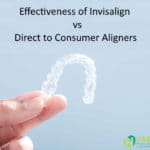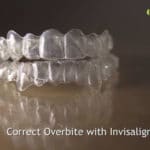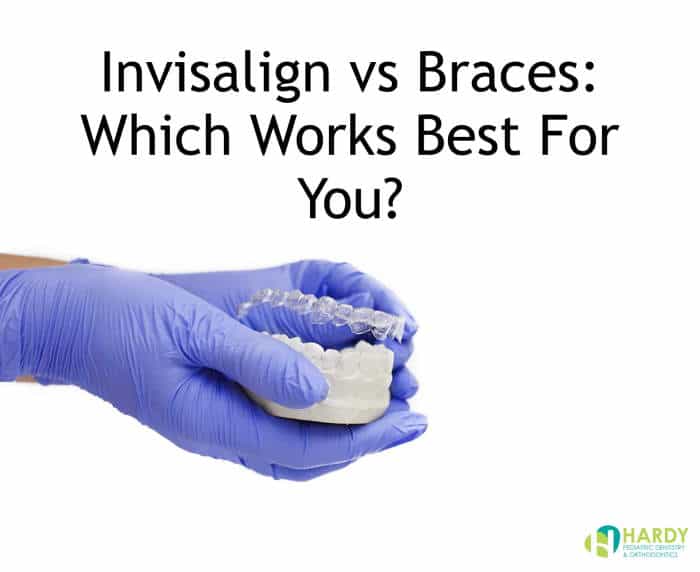According to studies, 96 percent of people believe that their smile is vital to their overall appearance. As a result, individuals opt to use braces or Invisalign in order to achieve perfectly aligned teeth.
But which option, between Invisalign and braces, is the most appropriate for you?
Advantages and Disadvantages of Invisalign over Braces
Invisalign works more quickly than traditional braces because the aligner trays are adjusted to each patient’s specific needs over the course of the treatment, making it more effective. Every few weeks, you’ll return to the office to pick up new aligners that have been custom-made for your needs. As a result, most patients complete their therapy in less time than they would have with braces.
Read: Invisalign to correct an overbite
Pros and Cons
Pros
They are nearly invisible. When people hear about Invisalign, the most common benefit they know is that these sets of aligners are nearly invisible. If you don’t love the “metal mouth” look of braces, then Invisalign is a great alternative for you.
With Invisalign, your teeth can be straightened without anyone even knowing about it. Movie stars, professionals, singers and anyone who doesn’t want to draw unwanted attention can benefit from this orthodontic treatment.
No dietary or food restrictions. Braces have a long list of foods you need to avoid or else you’ll end up with a damaged dental appliance that will put your orthodontic treatment in delay. Eating sticky foods for instance, can easily damage your braces. With Invisalign, you don’t have any restrictions on food.
It is easier to brush and floss your teeth. Brushing and flossing with braces are a bit more challenging than regular brushing which is why most patients don’t like metal braces, or ceramic braces. With Invisalign, there are no metal brackets and metal wire which makes your oral hygiene easy as you take the aligners off.
Fewer appointments. Braces take a lot of manual work and maintenance like bonding brackets, changing wires, replacing rubber bands, connecting springs that can take 20 minutes to an hour to finish while Invisalign takes just 10 minutes. Patients with braces need a 6 to 8 weeks interval while Invisalign only needs to be seen once every 10 to 12 weeks.
Less irritation and discomfort. Braces will cause sores, pain, and discomfort until your mouth is used to it. Invisalign, on the other hand, eliminates that pain and discomfort as it does not have brackets or wires.
Cons
You need to wear it for 21 hours a day. You only need to take your aligners when you eat or brush your teeth. If you don’t wear the aligners 21 hours per day, treatment time will take longer.
Speaking with aligners takes practice. Speaking with aligners can take a bit of practice at first, but you can adapt to it after a couple of days.
Complex tooth and bite problems may be difficult to correct. Sometimes traditional metal braces work best and are more cost-efficient, especially for complex cases.
Learn Invisalign Vs Smile Direct Club
Does Invisalign Work Faster than Traditional Braces?
Yes. When compared to traditional braces, Invisalign can straighten your crooked teeth much more quickly, as braces require 18 to 24 months of treatment time, whereas Invisalign only requires 12 to 18 months. Your case’s intricacy and the treatment plan’s duration will determine how long it takes to get the desired results.
Effectiveness of Invisalign vs Braces
For the purpose of straightening your teeth while also improving your smile and oral health, both Invisalign and metal braces or ceramic braces are regarded to be excellent instruments. While traditional braces are more effective at treating severe difficulties, Invisalign is considered to be the most effective treatment option, especially for moderately crowded teeth.
Cost Difference
Braces are often more expensive than Invisalign on average, although they are less expensive than traditional braces. Metal braces are typically cost between $1,800 and $6,000, and Invisalign is priced between $3,000 and $7,000.
Only your orthodontist will be aware of the overall cost of your treatment option, which will be determined by the intricacy of your case and whether Invisalign retainer or metal braces will be utilized. If your teeth require further attention and work, the fee will be higher.
Is Invisalign Better than Lingual Braces?
Unlike Invisalign, which utilizes clear, removable plastic aligners, lingual braces are permanently attached to your teeth and use brackets and wires to progressively correct the positions of your beautiful smile.
- Lingual braces are fully hidden in the mouth.The sheen that is often visible with Invisalign does not appear with this treatment.
- Orthodontists can exert the greatest amount of control over the movement of your teeth using these types of braces. They will be able to make minor modifications to your teeth till the completion of the treatment in order to get the desired results.
- Because your braces are permanently attached to the back of your teeth, you won’t have to bother about taking them out when you eat or drink.
- Every patient can benefit from this treatment. In addition, they are just as effective as traditional metal braces in addressing even the most severe cases of misalignment or tooth crowding.
Sources:
- Boyd RL. Esthetic orthodontic treatment using the invisalign appliance for moderate to complex malocclusions. J Dent Educ. 2008 Aug;72(8):948-67. PMID: 18676803.
- Kravitz ND, Kusnoto B, BeGole E, Obrez A, Agran B. How well does Invisalign work? A prospective clinical study evaluating the efficacy of tooth movement with Invisalign. Am J Orthod Dentofacial Orthop. 2009 Jan;135(1):27-35. doi: 10.1016/j.ajodo.2007.05.018. PMID: 19121497.
 What is The Difference Between Invisalign and Direct to Consumer Aligners
What is The Difference Between Invisalign and Direct to Consumer AlignersDespite the fact that they are both transparent aligners, these two devices are extremely different. Examine the differences between Invisalign and Direct to Consumer Aligners to choose which is best for you. How Effective is Invisalign Vs Direct to Consumer Aligners Invisalign and Direct to Consumer Aligners are both forms of transparent aligners used to […]
 Correcting Overbites with Invisalign
Correcting Overbites with InvisalignA malocclusion in which the upper front teeth overlap the lower front teeth is known as an overbite. It is the most common dental problem, accounting for more than 70% of all dental problems and resulting in an uneven and unnatural smile. We’re here to help you figure out if clear aligners like Invisalign can […]

